by Steve Hampton
Introduction
When assessing injuries to a spill, we typically seek to estimate, using scientific methods, the actual number of birds impacted by the event. For a variety of reasons, the number of birds collected (live and dead) on the beach may be only a small fraction of the total number impacted. The majority of the birds are never found. This page illustrates some of the reasons why. It is also important to note that a relatively small amount of oil on a bird (e.g., the size of a nickel) may result in death (see photo at right, with small amounts of oil on the breast). Like a hole in a wetsuit, the oil destroys the feathers' ability to insulate the bird, thus allowing cold ocean water to spread against the bird's skin. Birds typically die of hypothermia.
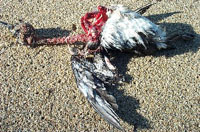
Scavenging
Coyotes, gulls, ravens, and other predators and carrion feeders may quickly prey on live beached birds or remove carcasses from the beach. OSPR studies have demonstrated that most birds disappear within 24 hours. This carcass is only hours old.
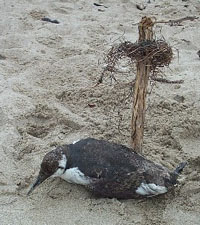
Removal or Burial by the Public
Beach-goers encountering dead birds may bury them or put them in garbage cans. This bird, shown here exumed from the grave next to its grave marker, was buried by the public within 20 minutes of its death. This is despite the fact that it was early in the morning and there were only four people on the beach.

At-Sea Loss
Experiments have shown that dead birds may float at sea for up to two weeks. However, wind and currents may carry such birds such that they never make landfall. This bird was apparently attacked and swallowed, then regurgitated. It was found floating at sea.
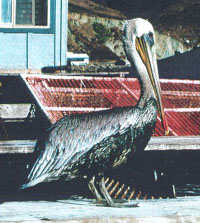
Departure from the Area
Large birds are sometimes able to travel long distances before succumbing to the effects of oiling. These birds may travel well outside the spill response zone and beyond the notice of responders. In some cases, we have documented birds travelling 60 miles from the spill site within two days. This Brown Pelican, heavily oiled on the belly, was found at Port San Luis during the Torch/Platform Irene oil spill. This location is approximately 40 miles from the spill site.
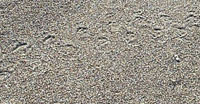
Beach Transit
The general assumption that birds come ashore and stay on the beach is not always valid. Common Murres, a seabird not known for walking great distances, have been found many hundreds of yards inland during oil spills. Sixteen sets of fresh murre tracks were counted on this 0.75 mile-long beach, all heading straight out of the water and up into the dunes. However, no birds were found despite intensive searching.
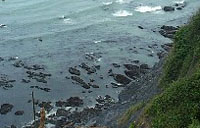
Unsearched Areas
Significant stretches of the coastline often go unsearched because they are inaccessible. While it is sometimes assumed that such reflective coastlines are non-depositional, a recent OSPR study revealed that birds do wash up on such beaches if rocky pockets exist.
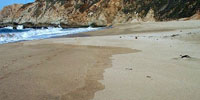
Search Efficiency
OSPR studies have shown that finding beachcast birds is not so easy. In fact, search efficiency plummets with small, dark-bodied birds. In this photo, on a beach free of wrack and other material, note the footprints (far left) of the observer who missed this carcass (far right). Beachcast birds are easily overlooked on cobble shorelines strewn with kelp and debris.
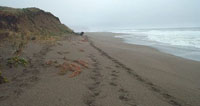
Re-Wash
Some beaches have sand at low tide, but are swept clean at high tide. A recent OSPR study shows that some birds are scavenged on land, swept back into the sea, sink, and are further scavenged by crabs.
References
Anderson, D.W., F. Gress, and D.M. Fry. 1996. Survival and dispersal of oiled brown pelicans after rehabilitation and release. Marine Pollution Bulletin 32: 711-718.
Bibby, C.J. 1981. An experiment on the recovery of dead birds from the North Sea. Ornis Scandinavica 12: 261-265.
Bibby, C.J. and C.S. Lloyd. 1977. Experiments to determine the fate of dead birds at sea. Biological Conservation 12: 295-309.
Burger, A.E. 1993. Estimating the mortality of seabirds following oil spills: Effects of spill volume. Marine Pollution Bulletin 26(3): 140-143.
Camphuysen, C.J. and M. Heubeck. 2001. Marine oil pollution and beached bird surveys: the development of a sensitive monitoring instrument. Environmental Pollution 112: 443-461.
Castege, I., Y. Lalanne, V. Gouriou, G. Hemery, M. Girin, F. D’amico, C. Mouches, J. D’Elbee, L. Soulier, J. Pensu, D. Lafitte, and F. Pautrizel. 2007. Estimating actual seabird mortality at sea and relationship with oil spills: lesson from the ‘‘Prestige’’ oil spill in Aquitaine (France). Ardeola 54: 289-307.
Flint, P. L., and A. C. Fowler. 1998. A drift experiment to assess the influence of wind on recovery of oiled seabirds on St Paul Island, Alaska. Marine Pollution Bulletin 36: 165-166.
Flint, P.L., A.C. Fowler, and R.F. Rockwell. 1999. Modelling bird mortality associated with the M/V Citrus oil spill off St. Paul Island, Alaska. Ecological Modeling 117: 261-267.
Ford, R. G. 2006. Using beached bird monitoring data for seabird damage assessment: the importance of search interval. Marine Ornithology 34: 91-98.
Ford, R.G., G.W. Page, and H.R. Carter. 1987. Estimating mortality of seabirds from oil spills. 1987 Oil Spill Conference Proceedings. Baltimore, MD.
Fowler, A.C. and P.L. Flint. 1997. Persistence rates and detection probabilities of oiled King Eider carcasses on St. Paul Island, Alaska. Marine Pollution Bulletin 34: 522-526.
Golightly, R.T., S.H. Newman, E.N. Craig, H.R. Carter, and J.A.K. Mazet. 2002. Survival and behavior of Western Gulls following exposure to oil and rehabilitation. Wildlife Society Bulletin 30: 539-546.
Irons, D. B., S. J. Kendall, W. P. Erickson, L. L. McDonald, and B. K. Lance. 2000. Nine years after the Exxon Valdez oil spill: effects on marine bird populations in Prince William Sound, Alaska. Condor 102:723-737.
Lewis, S.J., and R.A. Malecki. 1984. Effects of egg oiling in larid productivity and population dynamics. Auk 101: 584-592.
Massey, G., Hampton, S., and M. Ziccardi. 2005. A cost/benefit analysis of oiled wildlife response. Proceedings of the 2005 International Oil Spill Conference, May 15-19, 2005, Miami, FL
Moskoff, W. 2000. The impact of oil spills on birds: Looking back at the Exxon Valdez. Birding February, 2000: 44-49.
Oka, N. and M. Okuyama. 2000. Nutritional status of dead oiled rhinoceros auklets (Cerorhinca monocerata) in the Southern Japan Sea. Marine Pollution Bulletin 40(4): 340-347.
Munilla, I., J.M. Arcos, D. Oro, D. Álvarez, P.M. Leyenda, and A. Velando. 2011. Mass mortality of seabirds in the aftermath of the Prestige oil spill. Ecosphere 2(7): Article 83.
Newman, S. H., R. T. Golightly, E. N. Craig, H. R. Carter, and C. Kreuder. 2004. The Effects of petroleum exposure and rehabilitation on post-release survival, behavior, and blood health indices: A Common Murre (Uria aalge) case study following the Stuyvesant petroleum spill. Final Report. Oiled Wildlife Care Network, Wildlife Health Center, University of California, Davis, CA.
Page, G.W., H.R. Carter, and R.G. Ford. 1990. Numbers of seabirds killed or debilitated in the 1986 Apex Houston oil spill in central California. Studies in Avian Biology 14: 164-174.
Piatt, J. F., and R. G. Ford. 1996. How many seabirds were killed by the Exxon Valdez oil spill? Pages 712-719 in S. D. Rice, R. B. Spies, D. A. Wolfe, and B. A. Wright editors. Proceedings of the Exxon Valdez Oil Spill Symposium, Anchorage, Alaska, 2-5 February, 1993. American Fish Society, Bethesda, MD.
Piatt, J.F., C.J. Lensink, W. Butler, M. Kendziorek, and D.R. Nysewander. 1990. Immediate impact of the 'Exxon Valdez' oil spill on marine birds. Auk 107: 387-397.
Van Pelt, T.I., and J.F. Piatt. 1995. Deposition and persistence of beachcast seabird carcasses. Marine Pollution Bulletin 30(12): 794-802.
Sharp, B.E. 1996. Post-release survival of oiled, cleaned seabirds in North America. Ibis 138(2): 222-228.
Wiese, F. K., and G. J. Robertson. 2004. Assessing seabird mortality from chronic oil discharges at sea. Journal of Wildlife Management 68: 627-638.
Wiese, F.K. 2003. Sinking rates of dead birds: Improving estimates of seabird mortality due to oiling. Marine Ornithology 31: 65-70.
Wiese, F.K. and I.L. Jones. 2001. Experimental support for a new drift block design to assess seabird mortality from oil pollution. Auk 118: 1062-1068.
Wiese, F.K. and P.C. Ryan. 2003. The extent of chronic marine oil pollution in southeastern Newfoundland waters assessed through beached-bird surveys 1984-1999. Marine Pollution Bulletin 46: 1090-1101.
Wilhelm, S. I., G. J. Robertson, P. C. Ryan, and D. C. Schneider. 2007. Comparing an estimate of seabirds at risk to a mortality estimate from the November 2004 Terra Nova FPSO oil spill. Marine Pollution Bulletin 54: 537-544.